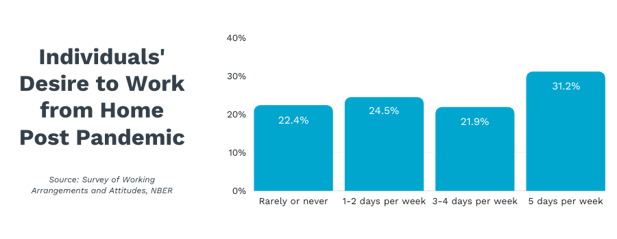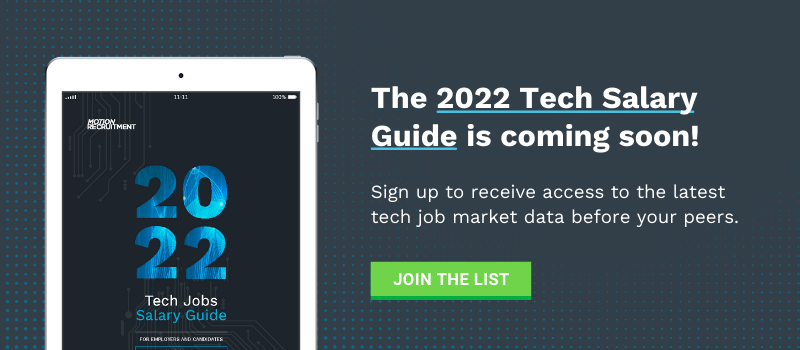In 2020 and 2021, the remote workplace became a necessity for companies around the world. As we continue to inch towards normalcy once again and offices open up, many workers are preferring to have permanent work from home options, with a recent study finding that over 75% of workers prefer working at least one day a week from home, and over 50% want to work remote at least 3 days a week.
As outlined in the tech salary report for 2022, 39% of employees have said they would quit their jobs if forced back into the office full-time. From research of hundreds of articles, one thing about the changing world of work is clear: the tech industry is reconsidering how work gets done, but it is not a one size fits all situation. Grab the 2022 Tech Salary Guide to learn more about how to navigate the long-term progression of the workplace here.
> Sign up to be first to receive the 2022 Tech Salary Guide <
Hybrid, Remote, or...not?
The benefits of a hybrid model are both for the company as well as the employee. Studies have found that remote employees are actually more productive, with one survey finding that last year, workers were 47% more productive year-to-year. Also, with a remote workforce, companies can open up a candidate pool as wide as they so desire, no longer being tethered by the constraints of how long a person is willing to commute.

However, the desire and ability to work from home is not unanimous. Even in the tech industry, there are tasks that can only be completed onsite. Also, as shown in the graph below, we see that 68% of employees want to be at the office at least once per week.

Navigating the long-term transformation of work
1. Decide your needs. How can you decide what is best for you? The first thing to do is actually pretty simple, just communicate - whether asking yourself or your team what's needed. Workers should think about the pros and cons of what it will mean to work from home. Do you have the space for a home office? Can you avoid distractions and maintain productivity? How valuable are in-person interactions to you? What impact will there be on your salary or career?
2. Examine employer expectations. Employers in general also need to ask questions. First, what do your employees want? Putting out an anonymous survey to your team can give you a feel of what they are looking for in a work environment. Having a solid grasp of what employee expectations are and what they value will guide employers on hybrid work decisions. Once those decisions have been made and if you choose to create a hybrid workplace, work with your IT department to set up the infrastructure needed to get business moving and all stakeholders happy.
3. Prepare for long-term adjustment. All that being said, it’s clear that working from home is here to stay, especially inside the tech industry. With the hybrid model rising in popularity, companies must be proactive to ensure its success if/when implemented. Phil Perkins, Vice President at Motion talked about the importance of flexibility and communication in a hybrid workplace at a recent Tech in Motion Event saying "Workers are looking for places where they can be onsite, but not at strict times." He continued, "The most successful remote workers will be the ones that are most proactive in communication."
4. Make sure it's sustainable. Creating a culture of inclusion and communication is paramount to having a dynamic team of hybrid workers. In all of these studies online about remote work, there is minimal universal agreement. Employers working with employees to find the best way (and the best place) to get work done will lead to the most production and job satisfaction. In addition, as restrictions are being lifted, many workers are interested in once again interacting with co-workers in person. As Kelli Jensen, Executive Director of Enterprise Talent Services at Motion told us, "Even if 100% remote, employees are looking for occasional in-person team building events inside their departments."
If a hybrid work model is done haphazardly, the possibility of employee disengagement and apathy to culture exists. The fact of the matter is most employees are looking for at least the option for remote work, and companies forcing workers back to the office is one of the drivers of The Great Resignation of 2021.
In a short amount of time, a flexible, hybrid work model has become one of the biggest things candidates are looking for when searching for job opportunities. Companies that are steadfast in their insistence on having employees come into the office every day run the risk of looking outdated and might lose out on top talent in the industry. However, those that adapt to this changing landscape and create an environment where teams can collaborate and produce work anywhere in the world will be ones that thrive in 2021 and beyond.
Ahead of the Tech Salary Guide for 2022, our event series Tech in Motion chatted with some recruiting and industry experts about the Future of Work. For more insights into the Hybrid Workplace as a part of the conversation, watch the video below.
With numerous hybrid and remote opportunities available across North America, contact your local Motion Recruitment office if you're in the tech space and looking for a new opportunity. Motion has been bringing together the best candidates in tech with some of the top companies in North America for over 30 years. Our expert recruiters are ready to help you with the next steps of your career.

Motion Recruitment















.jpg)
